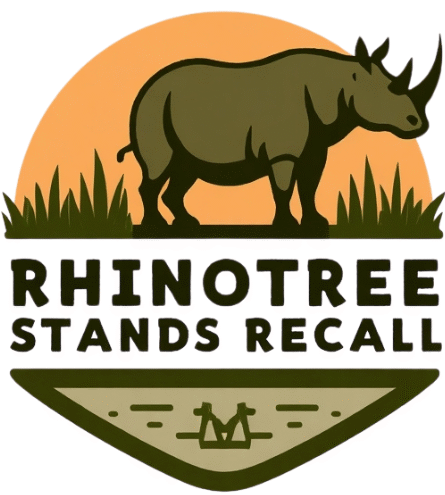Human encroachment and hunting practices have caused significant emotional, behavioral, and physical stress to one of the world’s most iconic creatures—the rhinoceros. Forest trauma, a term used to describe the psychological and ecological disturbances experienced by wildlife in response to human-induced stressors, has particularly severe consequences for rhinos. As highly sensitive megafauna, rhinos respond deeply to human presence, whether through poaching, habitat disturbance, or even eco-tourism.
Psychological Responses of Rhinos
Mental stress symptoms in rhinos often mirror the trauma seen in humans and other mammals under pressure.
- Altered social behavior, such as increased aggression or isolation
- Hypervigilance toward sounds or scents associated with humans
- Sleep disturbances and shortened rest cycles in disturbed areas
- Decreased maternal bonding due to stress hormones affecting parenting behavior
- Flight behavior increases without clear threats, leading to energy depletion
Psychological Signs in Rhinos Due to Human Disturbance
| Stress Indicator | Observed Effect | Impacted Rhino Populations |
|---|---|---|
| Increased vigilance | Frequent scanning of surroundings | Black rhinos in Kenya, Indian rhinos |
| Aggression spikes | More frequent horn clashes among males | White rhinos in South Africa |
| Avoidance of waterholes | Fear associated with previously poached areas | Greater one-horned rhinos in Assam |
| Maternal neglect | Early abandonment or rejection of calves | Captive and semi-wild rhino mothers |
Behavioral Shifts in Response to Humans
Rhinos modify their natural patterns when they detect frequent human activity, especially in areas associated with poaching or deforestation.
- Time shifting of activity from day to night to avoid humans
- Reduced territory use, confining movement to limited “safe” zones
- Increased vocalizations to warn others or express anxiety
- Group dispersal, especially among white rhino herds
Behavioral Adaptations by Region
| Region | Primary Behavioral Shift | Human Impact Factor |
|---|---|---|
| Kaziranga National Park | Nocturnal activity increases | Eco-tourism and illegal hunting |
| Kruger National Park | Shrinking territorial range | Armed patrols and vehicle tracks |
| Chitwan National Park | Calf vocalization rise | Nearby settlement expansion |
| Hluhluwe–iMfolozi Park | Fragmented herd movements | Poaching pressures and fences |
Physiological Impacts of Hunting Pressure
Stress in rhinos also manifests physically, disrupting body systems and reducing their reproductive success.
- Elevated cortisol levels, a primary stress hormone
- Suppressed immune function makes rhinos prone to infections
- Reduced fertility rates, especially among older females
- Lower calf survival, due to poor maternal conditions
Physiological Consequences of Hunting Stress
| Physical Outcome | Mechanism of Occurrence | Resulting Risk |
|---|---|---|
| High cortisol levels | Prolonged stress from poacher’s presence | Impaired digestion and restlessness |
| Infertility | Hormonal imbalance triggered by trauma | Decline in rhino population growth |
| Weak immunity | Stress hormones suppress white blood cells | Susceptibility to disease outbreaks |
| Calf mortality | Reduced milk production in stressed mothers | Population vulnerability |
Forest Habitat Fragmentation and Disruption
Human encroachment leads to forest fragmentation, which is a root cause of habitat stress. Rhinos require large, undisturbed territories to thrive.
- Road construction splits critical migration and feeding routes
- Logging and farming lead to the degradation of shelter zones
- Noise pollution disrupts communication and mating behaviors
- Increased edge effects bring in more predators and human contact
Habitat Fragmentation Impact on Rhino Behavior
| Type of Fragmentation | Consequence for Rhinos | Ecological Risk |
|---|---|---|
| Road development | Disrupted migration and increased accidents | Genetic isolation |
| Agricultural intrusion | Reduction of grazing zones | Nutritional deficiencies |
| Settlement expansion | Rhinos pushed to high-risk fringe zones | Human-wildlife conflict |
| Logging routes | Erosion of nesting or resting grounds | Forced dispersal of herds |
Responses to Conservation and Human Management
Rhinos display varied responses to conservation interventions. While protective efforts help, they sometimes bring unintended stress due to handling, tagging, or relocation.
- Translocation trauma is seen in relocated rhinos, which lose their territorial memory
- Collar tagging stress causes irritation and sometimes injury
- Enclosure behavior changes in fenced conservancies
- Habituation risks due to proximity to human caretakers
Conservation-Induced Stress Factors
| Conservation Action | Rhino Response | Recommended Mitigation |
|---|---|---|
| Tagging with radio collars | Skin abrasions, behavioral irritation | Use of lighter, skin-sensitive devices |
| Translocation | Disorientation, rejection of new habitats | Gradual acclimatization periods |
| Use of helicopters | Panic behavior, maternal separation | Quiet zone establishment |
| Fenced sanctuaries | Altered breeding and movement patterns | Rotational space design |
Emotional Memory and Trauma Retention
Rhinos possess strong memory and can retain emotional trauma over years, especially if associated with violence or capture.
- Returning to poaching sites is avoided even after years
- Avoidance of human clothing scents
- Recognition of gunshot sounds causes panic even in secured areas
- Calves orphaned by poaching exhibit chronic behavioral issues into adulthood
Memory-Based Trauma in Rhinos
| Trauma Trigger | Behavioral Aftermath | Long-Term Impact |
|---|---|---|
| Past poaching incident | Avoidance of once-used trails or rivers | Loss of optimal habitat use |
| Maternal death by hunters | Anxiety in orphaned calves | Social dysfunction in adulthood |
| Violent relocation | Fear of transport vehicles | Resistance to future conservation efforts |
Summing Up
Forest trauma in rhinos reveals the profound emotional, physiological, and behavioral consequences of human interference. Rhinos, despite their strength, are incredibly vulnerable to stress from human presence, hunting, and even some conservation practices. Long-term protection must prioritize minimizing unnecessary human contact, preserving large contiguous habitats, and refining conservation methods to reduce stress-related damage. Understanding the depth of rhino trauma can lead to more empathetic, science-based policies that foster true recovery in both wild and managed populations.
